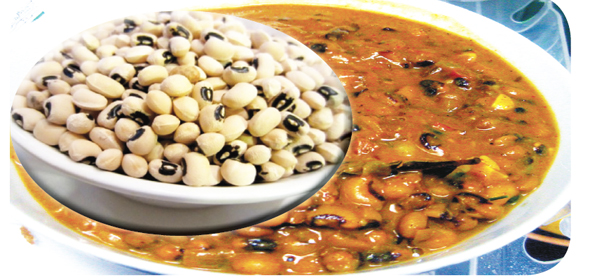Mama’s Punjabi Recipes: Lobia Di Kurri (Black Eyed Pea Curry)
Among all the beans and daals that are eaten by Indians, there are only a few that can be prepared either cold or warm and the two dishes would be completely different. In this category is the green moong daal and the lobia (black eyed pea), although some may serve kala chana (black chickpeas) cold on some rare occasions as a snack.
Lobia is usually called rongi in the Punjab, but it is generally popular all over India especially for their soft buttery taste and as they are much easier to digest than other beans like chole (chickpeas) and rajma (kidney beans). Also, you can add other vegetables like potatoes and onions along when cooking lobia, which adds to its popularity.
Lobia is a legume that grows in long pods and the color of the eye may be black, brown, red, pink or green. All the beans are green when freshly shelled and brown or buff when dried. As with other beans, they are high in carbohydrates and so are a high source of dietary fiber, a virtually fat-free source of high-quality protein and also contain high amounts of folate, magnesium, manganese and phosphorus which help reduce heart problems.
Black eyed peas are very popular in the southern US, where it is considered lucky to eat them cooked with pork, onion and a hot chili sauce on New Year’s Day as they will bring prosperity in the new year. They are also a very popular side dish in many country style restaurants.
You can easily find frozen bags of black eyed beans in most grocery stores and so the basic curry recipe is quick and easy to make. Just make sure that the consistency of the turri should not be too thick and especially not thin like water. To add to the taste, do add hing (asafoetida) and garam masala.
Ingredients :
400 gm lobia (black eyed pea) if using frozen, large bag, but do not thaw
2 medium piyaaz (onion) – peeled and finely chopped
1 tbsp tamater paste (tomato paste)
2 cloves of lasan (garlic) – peeled and finely chopped
1 tablespoon adrak (ginger) – peeled and finely chopped
2 tablespoons of vegetable or olive oil
2 cups of water
Spices (to taste): namak (salt), mirch (red pepper), haldi (turmeric), dhania (coriander), garam masal, hing (asafoetida)
Directions:
1. Wash the lobia well, then pour into a pot and let them soak overnight in warm water.
2. Pour them with the water in a pot and bring to a boil for 15 minutes. If you can find frozen black-eyed peas from the grocery store and use them instead, then skip this step.
3. In a medium saucepan prepare the masala in a medium frying pan. Heat 2 tablespoons of oil over medium heat, then add the onions, ginger, garlic and tomato paste. Stir well to make sure it doesn’t stick to the bottom. When the mixture is slightly brown, add the haldi and red pepper to bring out the color; add the rest of the spices and stir well.
4. Pour the lobia into the masala and stir fry for 5 minutes. If you use frozen lobia, pour right out of the bag into the masala and stir fry.
5. When the beans look slightly roasted, add two cups of warm water and cover the pot and bring the curry to a boil for 5 minutes. Reduce the heat to low and cook for five minutes. Do not overcook the beans as they need to be solid, not smashed.
6. Before serving, sprinkle with garam masala. The dish is ready to eat, usually with roti, rice or any variety of bread.
MAMA’S TIP OF THE WEEK
STORE POTATOES AND ONIONS IN THE OPEN FOR LONGER SHELF LIFE
To save money, people will buy large bags of potatoes and onions, both of which are used in Indian cooking a lot. But when they bring them home, they will store them in a basket on the bottom shelf of the pantry and usually forget about them. In a couple of weeks, they will start to rot and may even start to have sprouts. Most people will then turn around and throw these away.
To increase the shelf life of potatoes and onions, especially in the cold weather, put them in a basket, cover with a cloth and put it outside in a protected place in the shade. Ever so often, check them and turn them over to avoid bruising. They will last for a long time.
Shakuntla Malhotra is a skilled cook of Punjabi dishes made in the old-fashioned style that she learnt as a young woman in her ancestral home in Lyallpur, India before it became part of Pakistan after the Partition in 1947. People have often admired her cooking for its simplicity and taste that comes with each mouthful. Even in her mid-eighties, she continues to cook daily and agreed to share some of her delectable Punjabi recipes.


